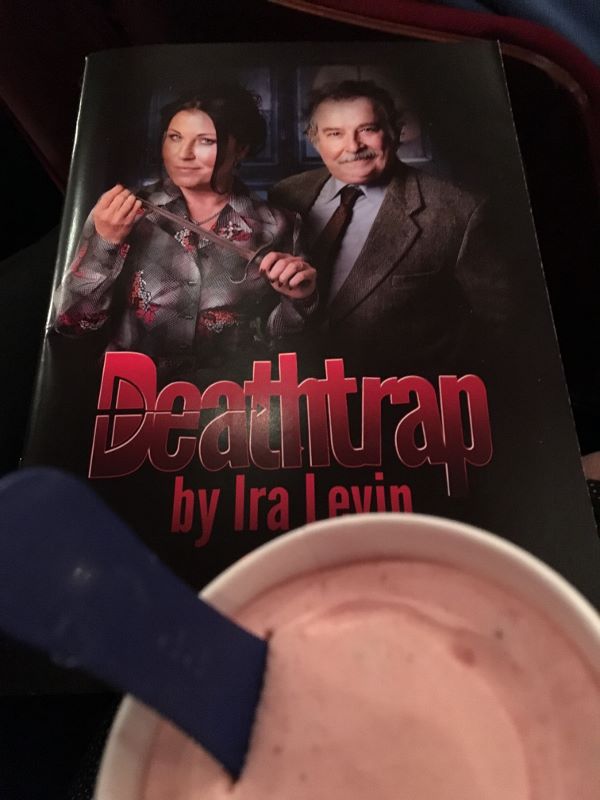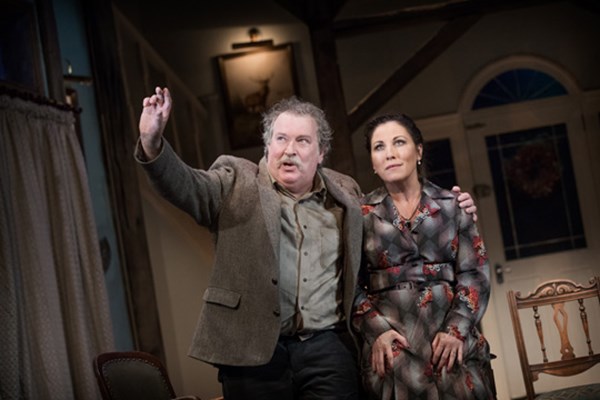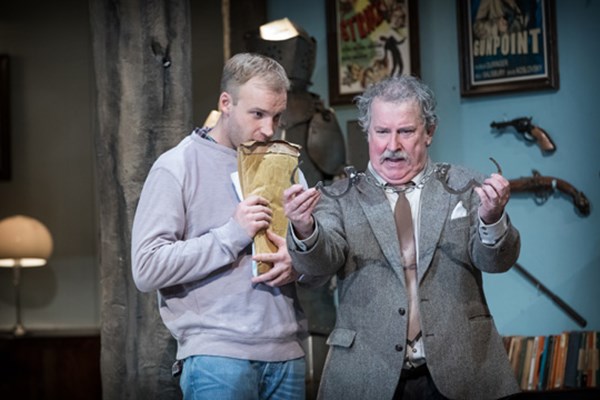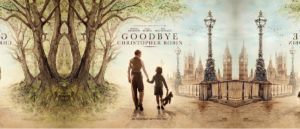
 (3 / 5)
(3 / 5)
Goodbye Christopher Robin is, at the start, about the rejuvenating ability that thinking as a child can help people through dark times and then becomes about the corruption of success and fame.
We are introduced to A.A. Milne (Domnhnall Gleeson) who has survived the First World War but is shell shocked and angry at the world. He lives rather comfortably in London with his wife Daphne (Margo Robbie) but he cannot get over the trauma, he introduces one of his plays but the spotlight reminds him of the lights in the trenches and cannot get through it. In his disgruntled state he decides to move his wife and son (Will Tilston) out to the country.
Whilst there Milne seems to be much more interested in woodwork and walking rather than writing. Daphne grows ever more bored and frustrated so she leaves for some city time, coinciding with her leaving the nanny (Kelly MacDonald) must also go for three days to see to her sickly mother. So now its just the two of them.
During the time they are away it falls on Milne to step up and take care of his son. He is not the most patient man so they have tension in deciding what breakfast to make and him needing quite. But he gets sucked into the world his son creates with his stuffed toys. We then hear other names and phrases and can connect the dots that these elements will be used to tell the tale we all know.
He of course writes it down and is a tremendous success. But with success comes fame so he is constantly being called and asked to make appearances. Even Milne, who wrote the book is always asked about his son. Public appearances, signings, interviews all in abundance. He can hardly go anywhere and not be recognized. Even in their country home people come looking for him.
Being that this is about the behind the scenes story of a popular work of fiction I couldn’t help but think of Finding Neverland and Saving Mr Banks. Out of all of these movies the best one is Finding Neverland but this is also a different movie. It shows the damaging effects of too much fame for someone that cant handle it.
This is a very handsomely shot movie with attention to detail in the living areas, wardrobe and the sunlight having a truly golden quality to it.
The movies message is a simple one and the story of what when on with the people behind the material is interesting. A few moments of cool transitions, attractive production value and very solid performances help make it more worth seeing it those elements weren’t there.
Tag Archives: Review
Review: Layton’s Mystery Journey by Sian Thomas
![]()
This review contains spoilers.
Trailer for Layton’s Mystery Journey: https://www.youtube.com/watch?v=hFz1tTNNRkM
As far as anyone was concerned this time in the last two years, the Professor Layton series was over. There were games and a movie and a book, and then it was finished. I remember how I felt the day some concept art snaked its way on to my timeline, and how incredulity and unimaginable excitement swelled in me: my absolute favourite series was still going. Some higher ups had decided not to leave us all the way that they had. How could I not be beside myself with utter glee? How could me, my friends who I met because of this series, how could we not let ourselves be absolutely encompassed by this incredibly lucky turn of events? We were so happy. I was so happy.
Layton’s Mystery Journey follows Katrielle Layton, Professor Layton’s daughter as she opens her own detective agency and solves a number of cases for London’s elite millionaires – the “Seven Dragons”. What I also thought was going to happen was throughout these cases, Katrielle would undergo the ongoing case of her father’s disappearance, since this is what I’d discovered was the #1 talking point whenever I looked into the game. “Professor Layton is missing! Will his daughter find him?” I thought she would.
As a series that existed differently to the previous Layton games, I obviously expected change. A new cast, new voices, new music, new scenery. I knew it was coming, so when it arrived there were no ill feelings between it and me. Much as how people say, “The movie would be good on it’s own” when the book was better but the movie was… okay… I can say that if this series didn’t have links to the older version, it would have been okay – it would have been good on it’s own. In some places it was even nice – to see things newly imagined. But my view was always going to be rose-tinted because of the old games, so I was helpless.
Some things were good. The music was good, but Layton music always has been (here’s a taste of this game’s music! : https://www.youtube.com/watch?v=4czbYlei3GY&list=PLVfglvX_VlEZniKUW5NEcdC_yaK6CipuV ). The puzzles were okay (since after all, it is a puzzle game), and I do appreciate that they existed as a tribute to the person who used to make the puzzles for these games, Akira Tago (1926-2016).
There was one character I did really love – Pipper Lowonida, the fictional Mayor of London (pictured on the right, below). She was the first character I saw! The concept art that found itself on my timeline was of her, and I always thought I’d like her. I was right! She’s the Mayor, but with a flare for festivals and parties, and with a happy and witty attitude. She was the best part of the game for me.

So, there was some good things. Not many, though, because now I have the chance to get into what really got under my skin.
This is something I realised a few weeks ago. I found myself less excited for Layton’s Mystery Journey as some of the other people I new. I thought maybe I had exerted it all too early, I thought the funny little online puzzle game (http://www.layton.jp/mystery-journey/laytonworld/uk.html) had depleted it (since I never finished it, and fell out with it just after it began). But, nope! It was something else entirely. I found myself reflecting on the prequel and sequel trilogies of the original Layton series, I found myself thinking quietly on how I loved their plots and characters until I stumbled on a big flaw. Lately with media I have been more than a little picky. Representation and mature story handling has become incredibly important to me, and I realised that the Layton series actually wasn’t ticking any of my important check boxes. Representation in terms of race? It wasn’t happening. Representation in terms of sexuality? Also wasn’t happening. In the original series there was one character who didn’t appear white – and he turned out to be a bad guy (bad move! Especially when this was the only non-white character of an entire series consisting of 7 games and one movie). This carried through into Layton’s Mystery Journey, unfortunately. There was one character who appeared non-white, yet his name was “Shadee” (it’s exactly what you’re thinking), and he was the main culprit of a case that our main characters were pursuing. They were pursuing him harshly, treating him badly, and didn’t apologise when they realised he wasn’t the culprit. (Bad move! It’s 2017 for goodness sake, show some compassion).
There’s also no representation when it came to sexuality. Heteronormative things came through easily in the past series (marriage, nuclear families, a young girl who gives a young boy a kiss and everyone in the vicinity giving each other those knowing looks even though the two kids in question were 11 at best), and this new game (the sidekick character, Ernest Greeves, is blatantly infatuated with the main character Katrielle. She doesn’t notice, and when she doesn’t another character is compelled to say things like “throw him a bone”, “give him a chance”. The problem I have with this is: Girls should not be prompted/feel obliged to appease a man just because the man in question has feelings for them. They shouldn’t have their independence and potential character growth thwarted just because a man has shown up and shown interest). Nothing about characters who weren’t straight, even though it is 2017. It’s disappointing, realising a series you love will not break the safe and traditional mould.
The last point? Every single plot of every single Layton game – and the movie – exists because of women’s suffering. This is a trope I do not at all like: “Woman gets hurt to unlock a man’s story”. So over the ten years that Professor Layton content has been being produced, it’s been the same story: a woman is hurt, somehow. A man’s story comes into existence because of this. So that’s all 6 original games, the crossover game, the movie, and this game! That’s bad. 9 times, a company can’t break from this storytelling? For ten years a company will keep themselves glued to this harmful storytelling? As the times change and representation and better treatment of female characters is needed and they do nothing? Yeah, I’m not exactly happy.
For this game, and for a long time, I really did not think they were going to fall into this trope. But they did, and it was right at the very end of the game. Turns out the bad guy was only propelled forward into taking the actions he did because his mother died. For this game I thought that, what with a new female protagonist, Level5 (the company behind the series) would be shepherded into treating their female characters better, but no. They don’t. They even forgive the antagonist, and move on like nothing ever happened. A white male character isn’t held accountable for his actions, but an NPC who appears black is lambasted endlessly through the case and treated poorly even if they did nothing wrong? I’m disappointed, massively so.
Continuing from that, here’s another of my big issues for the game: it is, as far as I’ve seen, hinged on the premise of “Professor Layton is missing – will his daughter, Katrielle find him?” And here let’s get into some big things that really made my blood boil: They barely mentioned this in-game. They barely talk about how the professor is missing, and when they do, it is off-handed mentions, vague information, and a flippant way of injecting it into the game as if no one really cares that this is the “overall plot” people were expecting. So, no, if you’re wondering, they don’t find the Professor. They don’t even look for him. There aren’t even hints throughout the 12 cases of this game that they plan on searching for him. Which is, let’s face it, a disappointment. I don’t know why advertising seemed to encircle this and then they go ahead and barely use it. I can understand that it’s likely to set up for a second game (which I don’t think I’ll be buying after my revelations and experiences with this game), but really what it felt like was laziness. A lack of a want to finish a story they led people to believe would be solved for the sake of making more money on the next instalment. Worse, they hinge a cutscene at the very end of the game in the post-credits, where it’s revealed that the main character, Katrielle, may not even be Layton’s daughter. She says she has solved the riddle Professor Layton left her (“If you’re not my daughter, then who are you?”). Some people took this as a good cliffhanger, but I took this as a slap in the face and the regrettable loss of £33.
I didn’t like it. Others may, and that’s fine, but Professor Layton content is no longer my cup of tea. I didn’t enjoy it and eventually trudging through playing it started to feel like a chore. Obviously I’m sad, I waited so long for this and was so excited and now I’m shrugging off a franchise I’ve loved for ten years. Hopefully this is better for me. With the fall of this, I just hope I can find better content I can throw myself into as deeply as I did this. Overall, I’m massively disappointed. One star.
Review The Rise and Fall Of Little Voice, Theatr Clwyd by Karis Clarke
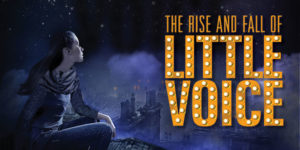
 (4 / 5)
(4 / 5)
As a critic I am not technically minded, I view a play and my mind will automatically focus on the acting ability of the cast , as my background is in performing. However it would be impossible not to be blown away by the genius set design and the technicality of this production.

Using a revolving room on a split level, and a dividing floor the design by Amy Jane Cook easily managed to give the illusion of an open dolls house. (If the dolls house was a northern council house with poor electrics and bad house keeping!) This enabled the lounge, kitchen diner and bedroom all to be in full view of the audience. With swift transitions the bedroom revolved, the living room divided and the set transformed to Mr Boo’s night club. The first transition took place just after the beginning of the second half and was met with suitable gasps of awe from the impressed full house.

It would be rude not to give credit to the lighting design, by Nicholas Holdridge although naturalistic in nature a majority of the play took place in dimly lit rooms and at one point darkness. However the clever use of street, moon, dawn and torch light ensured the actors were always well lit and the tone and atmosphere were heightened. This combination of stage and technical magic combine in the final stages of the production, not wanting to spoil the effect -Theatre Clwyd’s production does stay true to the film and they do so very effectively. A combination of smoke, lights movement and LV’s impressions as she reaches breaking point culminates to an intense stage experience.

The cast were as impressive as the set, comic timing, physicality and delivery were strong. Each member of the small ensemble allowed each other to have stand out moments as well as ensuring they all worked well together to perform some very funny dialogue, comedic banter and duets. (watch out for Nicola Reynolds, Mari Hoff, LV’s mum and the brilliant Victoria John, Sadie, the down beaten neighbour performing “It’s Raining Men”)
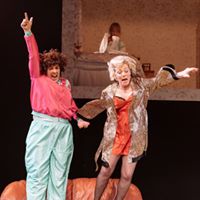
This play can only work if LV can actually deliver the impressions stated – ergo this play works. It has been stated on social media that when Catrin Aaron sings its like Judy Garland is in the room. I fully agree – except Shirley Bassey, Marilyn Monroe and a host of others are there with her.

I was slightly disappointed with some of the direction of the play, continuity of stage exits occasionally seemed haphazard – this could be due to them being sacrificed for the technicality of the production – in which case I can forgive the occasions when walls are walked through – however towards the end of the play it felt like the cast had forgotten where doors were and they were just walking wherever!
Jim Cartwright’s script is undoubtedly witty and gritty and is supposed to be full of hilarity and vulgarity, however, I was waiting for the all important point when I would feel empathy with the characters, for me, it didn’t happen. I put this down to the direction of Wasserberg rather than the acting ability of the cast. It was played for laughs and in doing so the characters became more caricatures – that although I laughed with, I never fully connected with.
Other than this, it was a pleasure to watch, strong female leads and the standing ovation was justly deserved. Little Voice hits the right notes.
Theatre Clwyd, Antony Hopkins Theatre,Tuesday 10th October . Directed by Kate Wasserberg
Review Deathtrap, New Theatre, Cardiff by Jane Bissett.
DEATHTRAP
By Ira Levin
 (2 / 5)
(2 / 5)
Deathtrap is the age old story of a man who wants more than he has and is prepared to go to any lengths to gain it.
The action takes place at the home of playwright Sidney Bruhl’s home that he shares with his wife of 11 years, Myra.
We see Sidney, a man who has not written a successful play for a number of years receives a manuscript from a aspiring young playwright. This is the opening of a plot that will change the course of the lives of Sidney and Myra in ways that we, the audience, will not have imagined.
The story covers four weeks in the life of Sidney Bruhl where he, Sidney, plans and plots to create a better life for himself at any cost.
The three main characters played by Paul Bradley (Sidney Bruhl), Jessie Wallace (Myra Bruhl) and Sam Phillips (Clifford Anderson), despite all being well known to us in former stage and television roles, were believable and I particularly liked Wallace’s portrayal of Myra Bruhl.
Despite not being familiar with the story and not having seen any other adaptation I didn’t find it as thrilling as I had anticipated. There were a lot of question marks about the relationships between the characters which were never addresses in either dialogue or behaviour except for the ending of act one. This isolated engagment between characters didn’t actually appear to have any relevance to the storyline and left the audience somewhat confused. Perhaps it was meant to shock? Either way it really didn’t work.
That said, the outstanding performance for me was Beverley Klein. She gave a wonderful performance as Helga ten Dorp, the Bruhl’s psychic neighbour. Her portrayal of ten Dorp single-handedly brought the thrills, drama and humour to the stage and was a delight to watch.
The set design worked well and the lighting created an atmosphere for day and night that worked particually well. The sound was spot on and certainly on cue for the moments we all jumped out of our seats! It would be unfair to elabarate further as it would certainly create a spoiler for anyone going to see the play.
Scene changes were prompted by the showing of vintage thrillers on screen in black and white which worked to great effect and enhanced the experience. The video design which was by Duncan McLean gave a sort of scrap book feel to the presentation and perhaps gave an insight to the mind of a thriller writer, their inspiration and method of work?
DEATHTRAP plays at Cardiff’s New Theatre from;
Tuesday 10 October – Saturday 14 October at 7.30pm
Wednesday, Thursday and Saturday Matinees at 2.30pm.
For further details or to book tickets call the Box Office on 02920878889.
Review Rip it Up, St David’s Hall by Barbara Hughes Moore

Dreamboats and Petticoats: Strictly stars tear up the dancefloor in Rip It Up
Having attended a fair few live shows featuring the Strictly cast, I can safely say that Rip it Up ranks among the best of them. Inventive, energetic and invigorating, Rip it Up was created, crafted and choreographed by fan favourite Strictly pro Natalie Lowe. Having recently left BBC’s flagship dance show after seven years (to the distress of many SCD fans, myself included), Natalie has shifted her considerable skill towards the theatre, being both the brains and brawn behind this 1950s-set dance spectacular. Joining her on tour are Strictly champions Jay McGuiness and Louis Smith, who lifted the glitterball with Aliona Vilani in 2015 and Flavia Cacace in 2012 respectively.
Directed by Gareth Walker, Rip it Up (named for one of the 50s songs it incorporates) follows the three principals and a slew of equally brilliant backing dancers as they shake, rattle and roll their way through some of the decade’s greatest songs – moving with ease from Elvis to Little Richard to Sam Cooke and Ritchie Valens. I’d forgotten how good these songs were, and how fabulous they are to dance to – but the considerable, combined talents of the Rip it Up ensemble brought it all back to me.
The show was split into different segments, each encapsulating a different type or trend of 50s music: rock ‘n’ roll, vocal harmony, blues, ballads, and Latin, as well as specific tributes to Buddy Holly, Elvis Presley, Little Richard and the Rat Pack. It was exhausting enough reading through the setlist, let alone watching the dancers perform to them! Natalie described the ensemble as the hardest working out there, and I certainly agree. Nothing was spared or suppressed – hearts and souls were bared on the dancefloor that night, and the audience was loving every second.
It was particularly gratifying to be a part of an audience that was as responsive to the show as I was – so often in modern theatre audience reaction is muted and formal, but just as the performers were giving every drop of energy and enthusiasm they had, so too were the people watching from their seats. Jay kindly acknowledged the audience response, thanking us for ‘making Monday night feel like Saturday night’. Well, Jay and the rest of the cast certainly made a rainy night in 2017 Cardiff feel like a summer’s day in 1955 NYC.
To enhance the feel of the time period, there was a brief TV montage interlude between each dance segment, showcasing some of the 50s’ cringiest commercials – including a toy advert for a truly bizarre sort of hula-hoop worn on the head called a ‘Swing Wing’, which was no doubt responsible for causing widespread whiplash during the decade. These were intercut with the ensemble’s pre-filmed cutesy interpretations of the era, as well as entertaining asides from the master of ceremonies, Leo Green, who also doubled as band leader and saxophonist.
Speaking of the music, the classic 50s hits were played with emotion and aplomb by a five-piece band, and what a joyful noise they made with so few. Along with Leo’s superb sax, we were treated to Ed Richardson on drums, Ian Jennings on bass, Jonny Dyke on keyboards and Matt White on guitars. I can’t stress how excellent the musicians were, including the two primary singers of the piece: Oliver Darling (who sported Buddy Holly glasses during his tribute) and Jill Marie Cooper, an exclusive treat for Cardiff audiences. They not only captured the spirit of the songs, but of the generation – although at times, they did tend to belt ballads that could have done with a softer touch. A small price to pay for the marvellous music overall – I would happily have paid to see the musicians and singers alone, but here they enhanced and accentuated the equally wonderful work of the dynamic dancers.
Natalie Lowe embodied the charm and elegance of the era, seamlessly slipping from Grace Kelly-esque screen siren to Elvis-like leather-clad rock ‘n’ roller, and countless other characters in between. She utterly evoked the ingenue of her introductory song, Jackie Wilson’s Reet Petite (‘the finest girl you ever want to meet’). Her standout number was a beautiful ballroom show-dance to the Righteous Brothers’ Unchained Melody, as well as a cheeky jive to a medley of 50s jitterbug. Not to mention she was responsible for overseeing and choreographing everyone else, and ensuring that every part had a unique and different feel, facet and flair. Her exit is a loss to Strictly, but a magnificent gain for the stage, and I can’t wait to see what she has waiting in store for us next.
Supporting our superb leading lady were two highly capable, and yet incredibly different, leading men: Jay McGuinness, whose unique brand of cool, chivalrous charm embodied the era’s sweetness simmering beneath the surface; and Louis Smith, whose fiercely flirtatious brand of fun complemented Jay extremely well. They couldn’t be less alike, except in their attempts to vie for Natalie’s affections, alternately foxtrotting and jiving their way into her heart. For two Strictly champions who had both been unfairly criticised by the judges for their supposed lack of personality during their tenure, it was particularly satisfying to see Jay and Louis not only having improved since their deserved wins, but infusing their routines with so much character, confidence and flair. They fit in perfectly alongside the pros, and skilfully held their own alongside them.
Jay’s entrance was the most impressive by far. Clad in black from head to toe, he spun around in the shadows and de-hatted himself, giving the impression that he had appeared out of thin air. He certainly encapsulated the gung-ho gusto of his intro song, Jerry Lee Lewis’ Great Balls of Fire. He also demonstrated a wide range of theme, technique and emotion (as he had done on Strictly), performing with passion and panache in every style of dance from waltz to cha cha and an artsy modern number to Nat King Cole’s Unforgettable that evoked his winning show-dance. And, of course, his jive prowess were second to none, as it has been ever since he and Aliona’s Pulp Fiction tribute broke the internet. Jay didn’t just shine whilst dancing; he also graced us with lovely renditions of some of the staple songs of the 50s, including the incomparably classy Beyond the Sea and a sultry rendition of Sway. Out of all the Strictly champions, Jay has the greatest potential to take the West End by storm – singing, dancing, acting, what can’t he do? I hope his recent stint as the lead in Big! The Musical is the first of many in a long line of stage shows in Jay’s future.
Louis, last but certainly not least, leapt onto the stage to Little Richard’s Tutti Frutti; from start to finish he looked like he was having the most fun by far – and that’s really saying something in an altogether joyous production. Although Louis performed in Strictly alum Robin Windsor’s Keep Dancing tour at Cardiff’s New Theatre last year, and has improved even since through joining Rip it Up, he confessed he hadn’t been sure if he could or should carry on dancing in live productions. But after a great experience with Natalie, Jay and the gang (and some vehement audience encouragement), it (thankfully) looks as though Louis isn’t going to hang up his dancing shoes any time soon. He looked as though he lived every moment of every dance, and possessed the most vibrant personality and stage presence of the entire ensemble. His gymnastics skills always shone during his Strictly stint, but here he has honed his dance technique and performance into sophisticated and stylish perfection. He excelled in solo, partner and group dances, really capturing the mischievous, rebellious feel of the era and starring in some of the strongest set-pieces: a sulky, sultry number to Peggy Lee’s Fever was a particular highlight, as well as a geeky romance against the backdrop of Sam Cooke’s Wonderful World. Louis’ Strictly journey keeps evolving, and long may it continue – Cardiff will certainly be there to welcome him back to the stage in the future.
If ever a stage show was an ensemble success, that show is Rip it Up. Every single backing dancer performed to the same superb standard as the principals and musicians, and were given ample time to shine both alongside and separate from the three leads, yet another testament to the team spirit of the entire production. Though the set itself was sparse, the performers and costumes made up for the minimal production values (totally understandable on a tour budget). However, despite how impressive the three leads’ solo numbers were, I would have loved to have seen the three of them sharing the stage more often. Natalie, Louis and Jay appeared together to bookend each segment, but then split up to perform numbers in which they individually featured (accompanied by partners or backing dancers), but rarely with one another. Because of the rarity of their onstage collaboration, one of the standout numbers for me was Jay and Louis engaging in what I can only refer to as a ‘James Dean-Off’ in which the two Strictly champs did their damned-est to out-Brando each other in rolled-up jeans and white Ts. In a similar vein, I think there should have been a story running through the show (just as Vincent and Flavia often have in their live shows); in doing so, they could build on the natural flirtation between Natalie, Jay and Louis, and incorporate their love triangle into a more structured through-line. It would have added a narrative cohesion to the excellent dance numbers, rendering them not only exciting but necessary in advancing the plot and our leads’ love lives.
Overall, Rip it Up is a truly wonderful theatrical experience that I urge anyone with even the vaguest interest in dance, music, theatre, The Wanted or gymnastics to go to if humanly possible. It’s great to see familiar faces again, as well as discovering new ones, and I can’t wait to see where Natalie, Jay, Louis and company go from here – I only hope that they keeeep dancing
http://www.stdavidshallcardiff.co.uk/whats-on/dance/rip-it-up/
Review The Mountain Between Us by Kevin Johnson

An interesting but flawed idea, two strangers survive a plane crash in the mountains, get to know each other as they try to walk out of the frozen wilderness, and begin to fall in love.
Idris Elba shows his star quality by holding his own against Kate Winslett. They have chemistry, and full marks for casting an interracial couple, but it doesn’t quite work.
Films like this drive me mad, because they’re so close to being brilliant, but fall short. The scenery, mostly snowy mountains, is amazing, the music is good, as is the direction, with some innovative touches. The script, however, lets everyone down.
Elba is an emotionally constipated neurosurgeon, Winslett a maverick photojournalist, both are strong-willed yet it’s she who drives them on while he wants to play it safe. So far, so good.
What could then have been developed into an interesting character piece, starts to unravel. Winslett keeps moaning about her poor fiancé, whilst the plight of the ten year old patient Elba was supposed to operate on is ignored.
It doesn’t help that the film is divided into ‘before and after’ section, which means the ending gets bogged down in romantic cliches that dilute the emotional momentum from before. There’s even a sex scene which, although beautifully filmed, jars with the story.
The film falls between two stools, neither a romance nor a survival thriller, although it tries to be both. Not a bad film though, just not a great one.
Oh and there’s a cute dog.
Review One Man, Two Guvnors, Black RAT Productions by Helen Joy
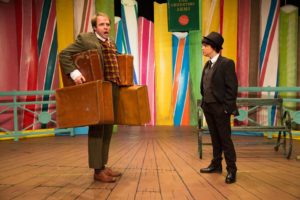
A slapsticky ribtickling romp through Mr Bean’s homage to the Italian original.
I love this theatre company. They make me laugh. Properly head back gasping for breath laugh. This multi talented bunch of actors and their production team are properly good.
I love the venue. I love the welcome. The busyness of the place. The swirly carpets and the polished wood and the atmosphere of years of local folk heading here for a night out. Marvellous.
And marvellous to take a glass of wine into the theatre and settle into your seat whilst the cast play their way through a series of ‘60s songs, washboard ‘n’ all. A band which reforms for set changes – how delightful, how clever to keep us all singing and clapping along.

Never afraid to look you in the eye, to include you in the action, to keep you alive with the threat of putting you too on the stage, it’s bright and buzzing throughout.
And the lead, Francis Henshall, is, quite frankly, fabulous! A tweedy oaf with a lust for food and a hunger for love, he draws us in, right in.
But he wouldn’t be half so good without his sidekicks.
Every character is perfectly overblown and overplayed. Exaggerated, exaggerating, they are funny and likeable and strangely believable. All very special in their own sweet Brighton rock kinda way.
Every seat is filled. Everyone is laughing. Everyone is having a very good time.
There is an energy to this production which drives through to the end.
Nothing unpredictable, nothing too challenging but what a wonderful slapsticking backslapping suitcase swapping utterly joyous night out!
Black Rat Productions is an extraordinarily talented company. There to be enjoyed.
One Man, Two Guvnors is a play by Richard Bean, an English adaptation of Servant of Two Masters (Italian: Il servitore di due padroni), a 1743 Commedia dell’arte style comedy play by the Italian playwright Carlo Goldoni.
Helen Joy for Get the Chance, 3rd Act Critics.
A Black RAT Productions, Blackwood Miners’ Institute and RCT Theatres co-production supported by Arts Council Wales
Cast
Gareth John Bale … FRANCIS HENSHALL
Lee Gilbert … HARRY DANGLE
Phylip Harries … CHARLIE CLENCH
Sarah-Jayne Hopkins … DOLLY
James Lawrence … STANLEY STUBBERS
Daniel Miles … ALAN DANGLE
Caryl Morgan … RACHEL CRABBE
Alice Strachan … PAULINE CLENCH
Chris Tummings … LLOYD BOATENG
Production Team
By Richard Bean
Based on The Servant of Two Masters by Carlo Goldoni
With songs by Grant Olding
Directed by Richard Tunley
Designed by Anna Marie Hainsworth
Production Manager / Lighting Design Robin Bainbridge
Stage Manager Claire Roberts
Musical Director Rob Thorne
Review Uncle Vanya, Theatr Clwyd by Donna Poynton
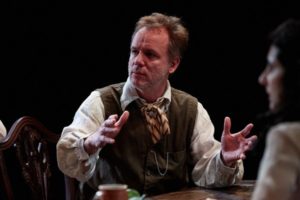
Uncle Vanya was first published in 1897 and had its premiere in Moscow in 1899, performed by the Moscow Art Theatre under the direction of Konstantin Stanislavski.
The play focuses on the visit of an elderly professor and his young wife Elena to the rural estate which supports their city dwelling lifestyle. Two friends, Vanya-the brother of the professor’s late first wife and the controller of the estate and Astrov-the local doctor, both end up falling for the charms of Elena. Sonya, the professor’s daughter by his first wife, is hopelessly in love with the doctor but her feelings are unmatched. Tempers flare and drama ensues as the professor announces his plans to sell the estate allowing Vanya to spiral into a madness offering tormented bawling and even a gunfight!
This new production written by Peter Gill and directed by Tamara Harvey of Chekhov’s doom-tinged comedy is set in the round, allowing for the feeling of immersion as an audience member, particularly during each characters’ soliloquy. We feel we are let in on the action, surrounding the players; close emotionally as well as physically. Each scene cleverly switches from outside to in and we are treated to some glorious pieces of silent acting as the characters themselves subtly manoeuvre the set to allow transitions (for example we hear claps of thunder and rainfall and a handful of actors swiftly grab chairs and rugs to ‘save them from getting wet’). The design of the piece, in this way, is very simple and yet we could look so much further into its meaning. Throughout the entire production there is an overhanging tree which could have been placed simply to remind us where we are. Could it, on the other hand, be symbolic of the overhanging, inevitable destruction in the piece?
The destruction of man and oneself is reflected in the frequent discussions of the desolation of the Earth’s forests. We cannot fail to spot the implications that humankind may not be KIND at all and that the dissatisfaction in our lives comes not only from ones own failings but from the failings of others to encourage success and happiness. We see love in all forms; love for family (as much as we may often speak ill of them or even wish then ill!), the love of nature, love of home, romantic love and even love unrequited but it appears that love brings with it sadness, frustration, sorrow and even utter despair!
Despite this, the play provides many moments of humour-mainly gleaned from the excellent characterisation of the title character by Jamie Ballard who portrays Vanya with just the right amount of comedy and tragic poise. This production has been cast superbly but special mention must also go to Rosie Sheehy as Sonya who plays the innocence and the pain of unreturned love beautifully, to Shanaya Rafaat as Elena who we are able to empathise with despite her somewhat ignorant demeanour and Oliver Dimsdale as Astrov who is both physically and mentally handsome-the stage often brought to life with each appearance.
This production of Uncle Vanya allows the stunning properties of Chekhov’s text to be fully appreciated as part of an up to date design. Despite it keeping its original 1890s setting we are able to relate the themes of the piece to our modern lives.
Review This Evil Thing, Sherman Theatre by Roger Barrington

 (4 / 5)
(4 / 5)
This didactic play tackles the controversial subject of conscientious objectors during World War One.
Conscientious objectors, or CO’s as the play’s devisor Michael Mears refer to them are those people who for various reasons refuse to fight or even engage in any activity that contributes to the promotion of warfare. These reasons may be religious, political or idealistic or a combination of more than one of these factors.
The most prominent character portrayed in the play is a man named Bert Brocklesby who was born and brought up near Doncaster as a Methodist but who had also interests in the Quaker and Baptist church movements. In fact, he eventually became a Quaker who are the religious group mostly closely associated with Conscientious objecting.
It is not the first recent play that focusses upon the CO’s during WW1. Both of these play examine CO’s within a regional basis, in contrast to “This Evil Thing” that examines a national set of affairs. In “Devils on Horseback”, a 2017 production by Goldsmith College, the trials of CO’s in Deptford are shown, based upon research of historians at the College. “England Arise” by Bent Architect portrays the activities of CO’s in Huddersfield. In fact, Yorkshire was a hotbed of co activity during WW1. This play has been criticised as feeling a little overlong, albeit the running time at 75 minutes is the same as the play under review here.
Positioning myself at the end of a crescent shaped set of rows at the Sherman Studio Theatre, I was easily able to notice my fellow audience member’s level of attention, for a play that demands it, and I am impressed by how riveted they were, which is testament to the engaging nature of this play. Mr Mears, at the end of the performance complimented the audience on their level of attention.
Michael Mears is a well-known and award-winning figure on the Fringe Theatre circuit for largely his one-man plays which he both writes and acts in. “Soup” another one-man play has won the Scotsman Fringe Award” which examines homelessness.
“This Evil Thing” was first performed at the Edinburgh Festival in 2016, and was well received.
“A thorough and at times gripping account of an important subject.”
4 out of 5 stars – The Scotsman
“Mears is an animated and engaging presence throughout, his faithful delivery of others’ words accommodating many a naturalistic flourish. Entertaining as his show may be, his gratitude and outrage remain very much to the fore. This is important, vital polemic.”
4 Stars out of 4 Fest (Edinburgh Festival magazine)
In an interview for the Stratford-upon Avon Herald in January this year, Mr. Meyers was asked the question how he would describe this play.
He replied, “It’s the compelling and rather shocking, and also inspiring, story of the First World War conscientious objectors (CO’s) in Britain, which has rarely been told or even talked about. In this period of commemoration of the war there’s a lot of focus on the battles, but I knew there would be plenty of material on that and wanted to write about something else. My grandfather fought in the First World War and my father in the Second but I don’t seemed to have inherited the genes, I’m a pacifist — so it seemed appropriate to focus on that. The full interview can be found here.
I would entirely agree with this.
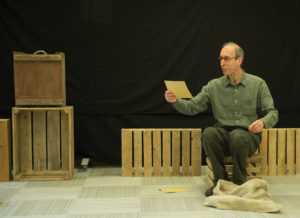
Image Simon Richardson
The design of the production is sparse in the extreme. Nine wooden boxes of different sizes, a wooden post and a bag amount to the set’s design. This minimalist approach works well, as due to the play’s physical nature, it allows Mr. Meyers to energetically move around the set. The boxes are used very creatively. For instance, they transform into a lectern, stretcher, bed, window, bench, representations of human figures in a military tribunal, coffin and even simulating gunfire by their sudden collapsing.
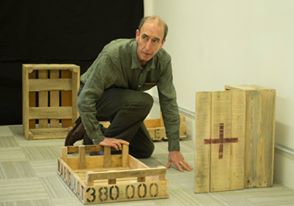
Image Simon Richardson
The play opens with a very effective use of lighting depicting a CO who was being punished by having to stand upon a box for hours upon end in a pit which has water lying at the bottom. The box protecting the prisoner from having to stand in the water. The only lighting on a totally dark stage coming from directly above. The play ends with the same scene. This very symbolic use of darkness and light can be interpreted in different ways which are not difficult to work out.
Over the course of the play’s seventy-five minutes, Mr. Meyers plays over fifty characters. An impressive feat, and I wonder whether the performer ever lapses into using the wrong voice, e.g, whilst playing a sergeant-major he slips into using a plummy public accent typical of a British army officer. His use of so many diverse voices and accents is one of the highlights of the play, as this compilation of scenes taken from the play illustrates.
The sentiment of the play is totally one-sided. Mr. Meyers is a committed pacifist and in a way, the play suffers from this one-dimensional view.
This is clearly depicted in the promotional flyer and poster.

The eponymous poster of Lord Kitchener pointing his figure towards all men able to fight, “Britons Wants You”, is mutilated by the red-cross, (symbolising blood), which intersect over the mouth, thereby gagging the message.
In a post-performance forum, I asked whether Mr. Meyers accepted that being a CO was essentially a selfish act. Naturally, he disagreed and the discussion was somewhat diverted into a matter of courage rather than the question I posed. My reason for implying this statement is that the CO’s were buoyed by their own strength of conviction, whereas his family were usually ostracised for his refusal to fight, with an inevitable implication of cowardice being the motivating factor. Contrast this to Junior Officers who suffered the highest casualty levels in WW1 over the men they led and their senior officers who were often protected well being the Front Line. Posing the question why these officers were prepared to die with almost an submissive inevitably, I suggested that largely it was due to protecting the family honour, thereby sacrificing themselves to protect the humiliation of cowardice from their loved ones.
Also, a scene where Bert Brocklesby refuses to peel potatoes because he was helping to prepare a meal for officers and men, on the basis that he would not help in any way the progress of war, I found to be trivial. However, I would concede that Mr Mears is only portraying the facts of a real life character, and others such as the eminent philosopher and later CND co-founder Bertrand Russell and Prime Minister H. H. Asquith also feature.
Mr. Mears is an engaging figure, both on and off stage. He is clearly fired up by the message he is bringing and totally committed to it. An interesting character in his own right, he is an active long-distance walker, which would aid his fitness level essential to his own brand of physical theatre.
This message is a worthy one. As to its relevance today is another matter. I cannot foresee, due to the technical advance of weaponry, a situation where conscription will ever be re-introduced. In today’s world, blessed by 75 years of involvement in international conflict on a national level, our attitudes towards CO’s has softened. The play reminds us that these men possessed a different type of bravery in swimming against the tide, and should be remembered with compassion and understanding for doing that.
On the performance I attended, the 100 seater theatre was just over half full. This is a sad reflection on the demands of theatregoers today. Many, it seems, see the role of theatre to be solely based upon entertainment factors, thereby omitting an essential aspect of theatre which should be to educate. The concentration ability in today’s world would appear to have been irreversibly damaged through instant revelation provided through technology. I compare it to 20-20 cricket as compared to a test match. Although, I will happily concede that there is a place for both, I fear that the relentless march of entertainment musicals, (whilst acknowledging their financial input often sponsors drama), may mean such important plays such as “This Evil Thing” will become a rarity.
Sherman Theatre is the opening venue of a two month tour which returns to Wales on :-
11th November 2017 Galeri Theatre, Caernarfon
24th November 2017 Aberystwyth Arts Centre
Full dates can be found here
“This Evil Thing” performed and revised by Michael Mears.
Directed by Rosamunde Hutt
Performed at Sherman Studio Theatre Cardiff 25th and 26th September 2017
Review Victoria & Abdul by Jonathan Evans

The opening text of Victoria & Abdul goes “Based on real events…mostly.” That insertion of the last part eases the audience that though the idea and some events may have accrued, they are taking liberties. It allows us to take some of the more eccentric moments and inaccuracy’s with a pinch of salt and enjoy the moments.
We open in India where a simple man names Abdul goes about his simple duties. By chance he is selected to present Queen Victoria with a gift, simply because he is tall. So he gets shipped off to England and when the pivotal moments comes he is instructed to not to make eye contact with her majesty. Guess what happens!
Dench is actually returning to the role of Victoria. She originally played the monarch in Mrs. Brown, where oddly, was also about the Queen befriending a servant. There’s not much to write about the performance I feel, Dench has proven her chops as an actor again and again. Here she handles the part of one of the longest running monarch’s as a woman that is more than used to getting her way, but also fatigued with the repetition of ceremonies and political news. It is when this young Indian servant enters her life that she becomes reinvigorated with someone that speaks to her like an equal and has a different view of the world.
Abdul played by Ali Fazal will most likely bring a smile to your face. He himself is so smiley and optimistic but not without a sense of being grounded. He can be sad and worried, but that is understood because he has his faith that reassures him of a positive outcome. If it were not for these moments then he would most likely become grading, but with these touches he is enduring.
Typically in these kinds of movies with big named stars and based on historical events you can bet that the studio and filmmakers are seeking an Oscar for their efforts. It may well win or at least be nominated for cinematography and/or costume design. But the moments that will most likely receive a nomination, even a win. This is a moment where Dench is framed in closeup and it never cuts away and she delivers a summary of this entire woman’s life and role. This, on one hand, it obviously trying hard to win the Oscar, but also on the other it is a sharply executed performance that is very well written.
Eventually there come moments of unhappiness and sombreness. Such moments in movies come and go with varying degrees of effectiveness but these ones truly struck me. It works by starting with sugary charm and digging deeper and deeper into the characters and the way each of their worlds work as well as life as a whole we come to truly tender moments.
Historical accuracy interest me rather little, what engages me is characters and themes, the movie has these. It has charm and fun but by the end leaves you with a sense of understanding of the connections between people.

